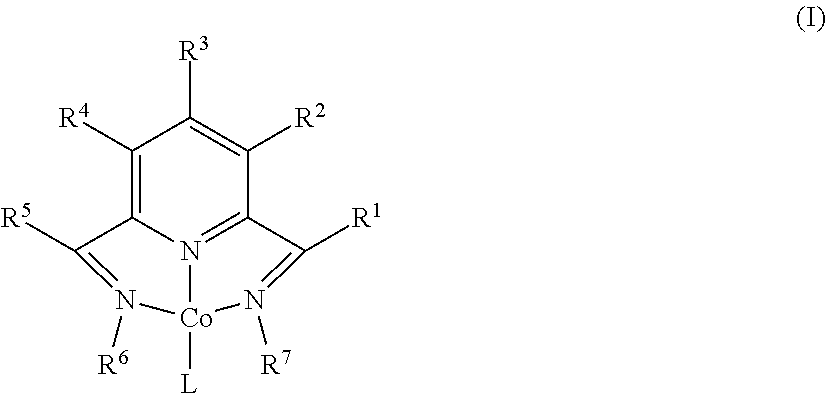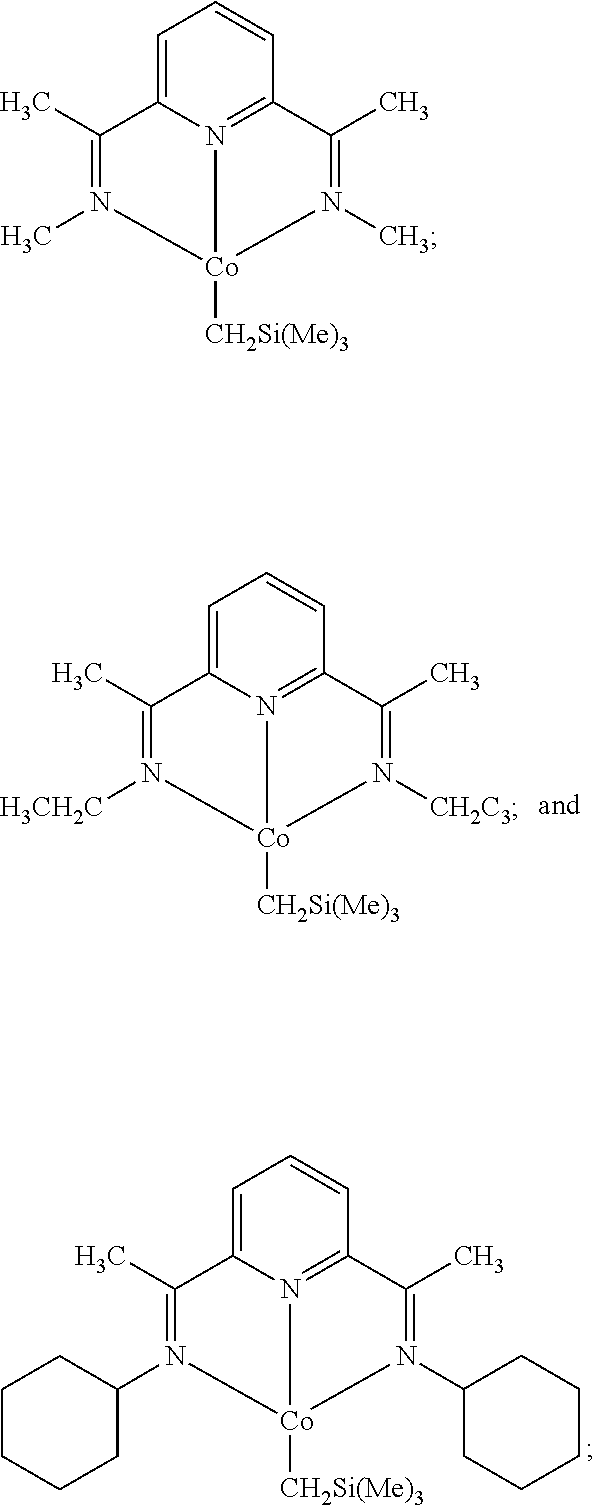Dehydrogenative silylation, hydrosilylation and crosslinking using cobalt catalysts
a catalyst and cobalt technology, applied in the direction of organic compounds/hydrides/coordination complex catalysts, physical/chemical process catalysts, organic chemistry, etc., can solve the problems of metal catalyzed hydrosilylation only working well, limited methods, and unsaturation of the original substra
- Summary
- Abstract
- Description
- Claims
- Application Information
AI Technical Summary
Benefits of technology
Problems solved by technology
Method used
Image
Examples
example 1
Synthesis of MeAPDICoNs
[0097]In a nitrogen-filled drybox, a scintillation vial was charged with 0.350 g (1.097 mmol) of MeAPDICoCl2 and approximately 14 mL of THF. The suspension was chilled at −35° C. for 20 minutes. To this suspension was then added dropwise a THF solution of (trimethylsilyl)methyllithium (0.207 g in 3 mL THF), during which time a solution color change to purple was observed. The reaction mixture was stirred at room temperature overnight, after which the volatiles were removed in vacuo. The residue was extracted with diethyl ether, filtered through Celite, and concentrated. Layering the supernatant with pentane and recrystallization at −35° C. yielded 0.155 g (42%) of a purple solid identified as MeAPDICoNs. 1H NMR (benzene-d6, 23° C.): δ=9.83 (t, 8 Hz, 1H), 7.21 (d, 8 Hz, 2H), 3.98 (s, 6H), 1.22 (s, 2H), −0.11 (s, 9H), −0.57 (s, 6H). 13C NMR (benzene-d6, 23° C.): δ=165.29, 152.49, 122.43, 114.04, 48.25, 30.25, 20.95, 3.39.
example 2
Synthesis of EtAPDICoNs
[0098]In a nitrogen-filled drybox, a scintillation vial was charged with 0.134 g (0.386 mmol) of EtAPDICoCl2 and approximately 10 mL of THF. The suspension was chilled at −35° C. for 20 minutes. To this suspension was then added dropwise a THF solution of (trimethylsilyl)methyllithium (0.073 g in 1 mL THF), during which time a solution color change to purple was observed. The reaction mixture was stirred at room temperature overnight, after which the volatiles were removed in vacuo. The residue was extracted with toluene, filtered through Celite, and concentrated. Layering the supernatant with pentane and recrystallization at −35° C. yielded 0.093 g (66.3%) of a purple solid identified as EtAPDICoNs. 1H NMR (benzene-d6, 23° C.): δ=9.80 (t, 8 Hz, 1H), 7.28 (d, 8 Hz, 2H), 5.21 (q, 7 Hz, 4H), 1.70 (t, 7 Hz, 6H), 1.17 (s, 2H), −0.13 (s, 9H), −0.37 (s, 6H). 13C NMR (benzene-d6, 23° C.): δ=162.77, 152.73, 122.55, 114.03, 53.59, 20.29, 12.52, 3.31, 0.05.
example 3
Synthesis of CyAPDICoNs
[0099]In a nitrogen-filled drybox, a scintillation vial was charged with 0.280 g (0.667 mmol) of CyAPDICoCl (Bowman, A. C.; Milsmann, C.; Bill, E.; Lobkovsky, E.; Weyhermiiller, T.; Wieghardt, K.; Chink P. J. Inorg. Chem. 2010, 49, 6110-6123) and approximately 14 mL of diethyl ether. The suspension was chilled at −35° C. for 20 minutes. To this suspension was then added dropwise a diethyl ether solution of (trimethylsilyl)methyllithium (0.066 g in 3 mL diethylether), during which time a solution color change from orange to purple was observed. The reaction mixture was stirred at room temperature for 1 hour, after which time the mixture was filtered through Celite, and concentrated. Layering the supernatant with pentane and recrystallization at −35° C. yielded 0.250 g (79%) of a purple solid identified as CyAPDICoNs. 1H NMR (benzene-d6, 23° C.): δ=9.68 (t, 8 Hz, 1H), 7.43 (d, 8 Hz, 2H), 6.93 (br, 2H), 4.27 (m, 2H), 3.15-1.18 (m, 20H), −0.01 (s, 6H), −0.45 (s, 9...
PUM
| Property | Measurement | Unit |
|---|---|---|
| Temperature | aaaaa | aaaaa |
| Temperature | aaaaa | aaaaa |
Abstract
Description
Claims
Application Information
 Login to View More
Login to View More - R&D
- Intellectual Property
- Life Sciences
- Materials
- Tech Scout
- Unparalleled Data Quality
- Higher Quality Content
- 60% Fewer Hallucinations
Browse by: Latest US Patents, China's latest patents, Technical Efficacy Thesaurus, Application Domain, Technology Topic, Popular Technical Reports.
© 2025 PatSnap. All rights reserved.Legal|Privacy policy|Modern Slavery Act Transparency Statement|Sitemap|About US| Contact US: help@patsnap.com



